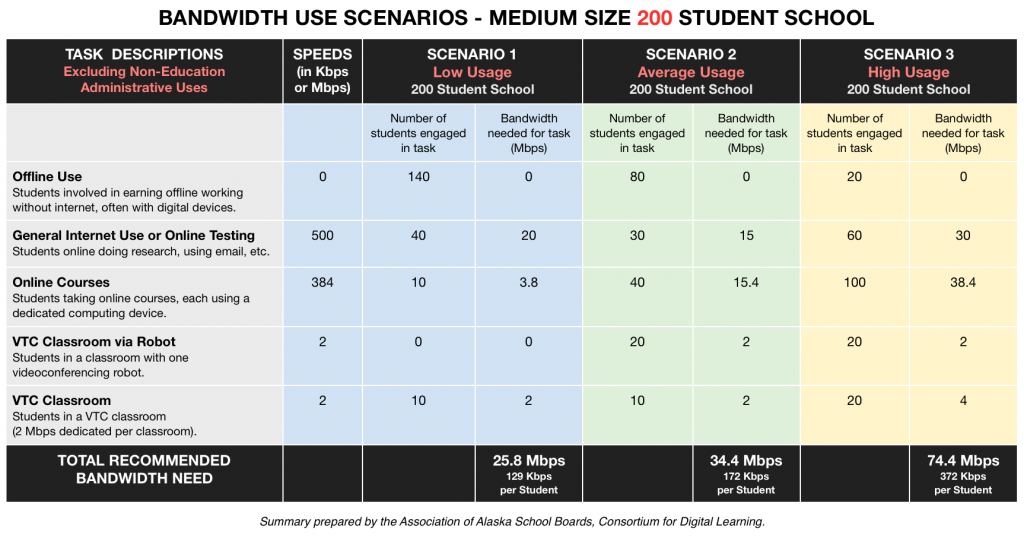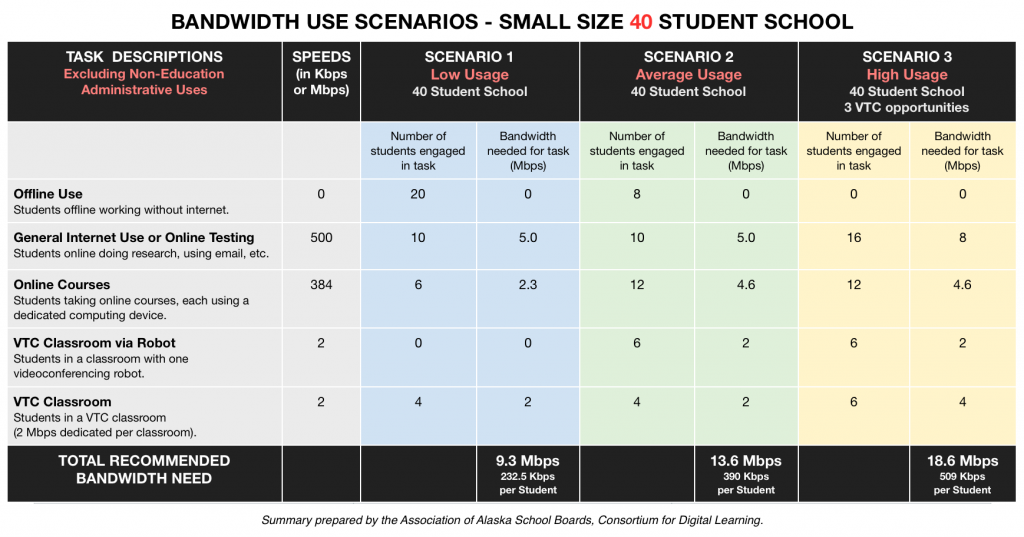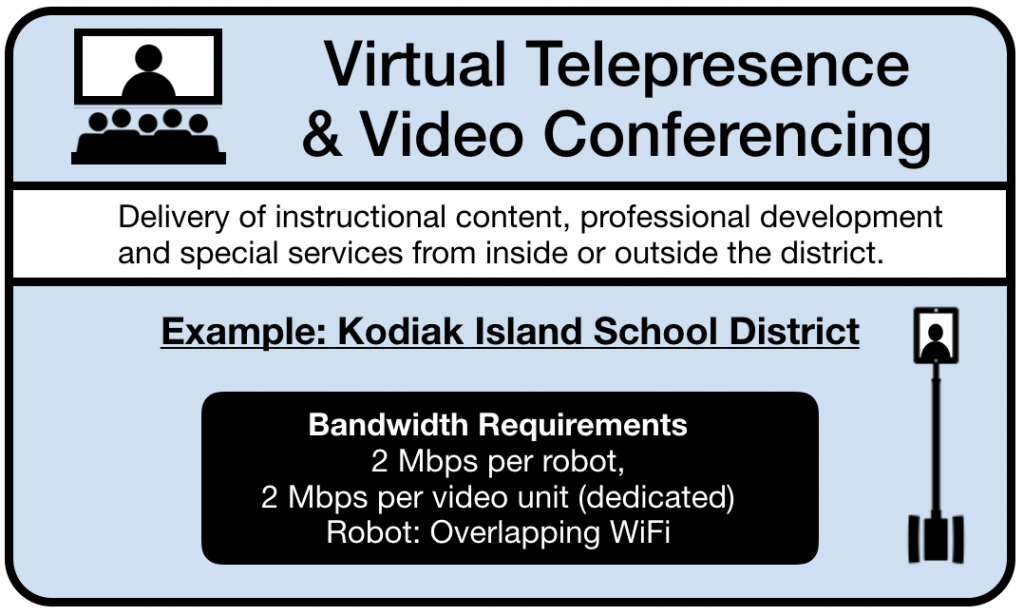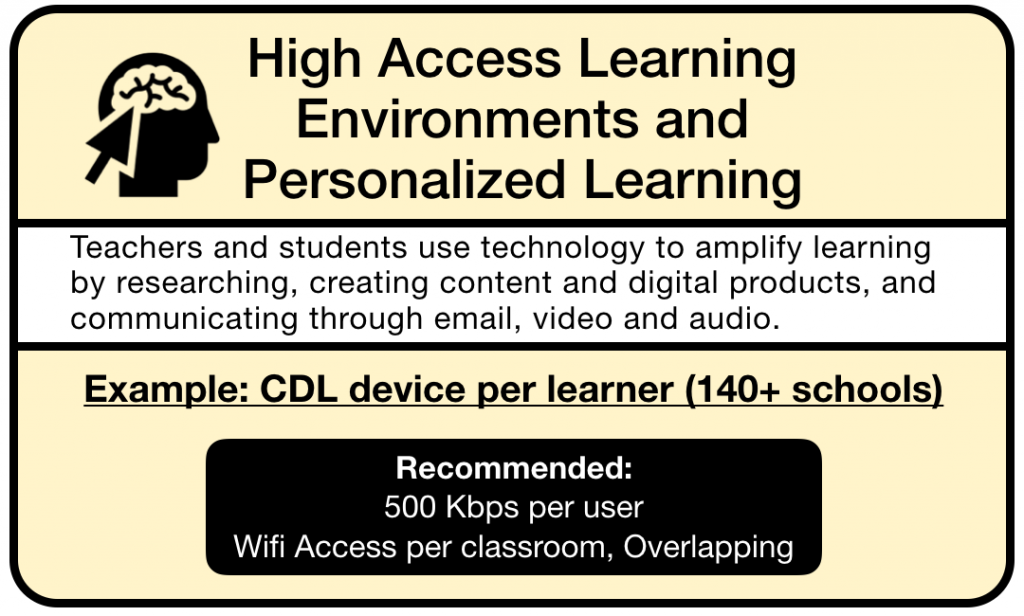A Network of Innovative Districts Can Move Alaska Forward
The Senate Education Committee listens to testimony from Dr. Bob Whicker via teleconference.
In his March 3, 2017 testimony to the Senate Education Committee, AASB Consortium for Digital Learning Director Dr. Bob Whicker outlined four areas that can help transition Alaska education to a digital learning model. The following is a transcript of his testimony.
Watch Gavel Alaska coverage of Dr. Whicker’s testimony (70 minutes)
Thank you for the opportunity to talk with you again.
I’ve watched testimony from many of the entities that have come before you. I will try to bridge the message they have been delivering and bring an added perspective from our experience at the Consortium for Digital Learning. From previous testimony, you’ve seen that schools are making progress toward using digital learning and providing meaningful relevant career/college readiness skills but face challenges in bringing this type of learning to all students. It is prudent to keep the overall goal in mind. Access to the appropriate technology for desired teaching and learning outcomes is what is transformational about this discussion. The ubiquitous access to digital learning and appropriate teaching tools that promote the types of educational experiences we desire is the thing that makes the difference. The power of the technology tools we use provides the nimbleness, effectiveness, and increased opportunities and potential for academic achievement that are not available without it. Improved broadband and higher technology adoption in our schools adds tools to achieve these things.
In previous testimony I outlined how the Consortium for Digital Learning has been an active advocate for the advancement of digital learning for all students in K12 since 2005. Through the support of the Alaska Legislature, we’ve assisted over 140 schools in implementing 1 to 1 laptop and tablet programs and districts have continued or expanded those programs. We have continued to advance digital learning in Alaska by creating examples of collaboration between districts, working with vendors to develop unique solutions to our challenges, and conducting demonstration projects and programs resulting in higher learning and systemic changes. These projects were great learning environments that laid the groundwork for where digital learning has progressed today in our State.
It is important to note that our successful implementations of digital learning advance by controlling variables that can be controlled and working around those that aren’t. Let me repeat that again… “Successful implementations control variables that can be controlled and work around those that can’t.” Sometimes this means learning to use the broadband you have to amplify and accelerate learning with the technology that is available. Improving and sustaining our broadband services will no doubt, greatly improve opportunities for our students, and is worth pursuing. Yet, while broadband is a crucial aspect to digital learning, improved broadband alone does not guarantee an improved educational outcome without addressing other aspects of digital learning. Commitment, innovation, and wise use of resources and district strengths have much to do with successful implementations.
The topics I will address today include:
- The types of learning broadband and the use of technology avails.
- The level of broadband and technology for a blended learning educational model in our state.
- Other challenges and possible solutions.
- A foundation of a plan for moving forward.
1) The first graphic titled “Use of Bandwidth in Instruction” highlights four examples of what types of learning that are broadband enables. These examples are promising innovations to Alaska’s educational model that modernize our instruction for increased efficiencies and expansion of offerings, to say the least.

At the top of the graphic is the published broadband recommendation for schools for 2018 from the State Education Technology Directors Association and President Obama’s ConnectEd Initiative. The figure of 1Gbps per 1000 students equals 1 mbps per student or 1000 kbps. That figure is presently beyond the great majority of Alaskan school districts and schools and far beyond those in rural Alaska.
The upper left corner of your graphic gives an example of Online Learning.
Our definition of this is the delivery of core courses or content online. You have heard from the Digital Teaching Initiative districts and Ketchikan Digital Academy is one highlighted here. Their main vendors are Canvas and Edgenuity, whose learning management software platforms are widely used across the state. Ketchikan serves 14 partner schools across districts. While offering courses through their Digital Teaching Initiative grant, they have built a model around a $250 per course cost to participants.
Vendor Bandwidth Recommendations are 384 – 512 kbps per concurrent user. Other online course providers in other schools specify up to 1.5 mg per student for their services. For areas with low bandwidth, a media appliance (server) helps provide content that does not need to be live.
Important lessons learned here are:
- An on-site adult to supervise learning is crucial, success of coursework is greatly dependent on that person.
- A central provider enables success and ease of use by consolidating efforts, streamlining administration and providing needed expertise to the end-user site.
The upper right of your handout highlights Virtual Telepresence and Video Conferencing. The definition we use for this is “the delivery of instructional content, professional development and special services from inside or outside the district through video”. Kodiak Island School District is highlighted as an example. Classes are taught from Kodiak to their villages through video conference including welding, music, fine art courses, and even coaching of sports teams. They also use of video conferencing robots for teacher professional development by instructors in the lower 48. Broadband connections serve village schools over satellite and there is a fiber terrestrial connection in Kodiak proper.
You have heard from other enterprising districts delivering content inside and outside the district from video conferencing studios. Outside technical and special services, as well as professional development, are also being delivered through mobile robots using telepresence.
Bandwidth recommendations from vendors for this type of video conferencing in static implementations is up to a dedicated 2 mg up and down. Districts are successful using less bandwidth employing expensive equipment and skilled technical expertise.
For Double Robots – 2 mg per robot is the recommendation, also running on less in our school environments.
Important Lessons learned here are:
- The video conference instructor must be engaging and engage students in learning. Just lecturing as the only mode is not inspiring. The importance of the on-site adult is crucial.
- Having the ability for video conferencing to be mobile (as in the case of robots) makes forming a relationship between participants much easier.
The lower left of your handout highlights High Access Learning Environments and Personalized Learning.
In this environment, teachers and students use technology to amplify learning by researching, creating content and digital products, and communicating through email, video, and audio. A dedicated digital device per student is recommended for maximum impact and are used a various times during the day as appropriate. Teachers moving through levels of technology adoption are central to this blended learning approach. Over 140 schools have some sort of 1 to 1 program serving some students and a few school districts that have all students with a per-user device to student ratio.
Bandwidth recommendations: 500 kbps per concurrent user to allow for basic productivity and WAN/cloud access. Many schools with 1 to 1 have less bandwidth per student and use shaping and network filtering to still meet instructional goals. The use of extensive streaming video requires more bandwidth.
Lessons learned here are:
- Professional development is critical, borne out in our doctoral studies. There is a high correlation between how much teachers use the technology to the amount of district PD is offered over time.
- The high access learning environment is a fundamental change needing leadership commitment, sustainable funding commitment, many layers of project support, focused curricular goals, and community support.
The lower right of your handout is an example of Collaborative Learning. Our example is the World Bridge Project between Copper River School District, Kodiak Island Borough School District, Trillium Learning, and NASA. Kodiak has sent two teams of high school students in this project to the Europa Challenge in Italy, a very high level competition between businesses and universities, and they have won both times.
The project between the Copper River School District and Kodiak had teams work across districts to design, build, and launch pre-earthquake sensors into high altitude as an experiment in gathering sensitive data for the project. Copper River students designed the rocket and Kodiak used computer imaging, 3D printing and sensor modification to design the payload. The launch was more than successful. Students and teachers used teleconferencing, video conferencing, and an online platform called Basecamp, used for creativity and the sharing and tracking learning activities and products.
If there are questions concerning this information, I can respond before proceeding to the next document.
2) In our experience, if we’re going to establish a distance delivery or blended learning model utilizing online learning, then we need to establish the kinds of learning activities we desire for our children, and then get to that bandwidth requirement.

With that in mind, the graphic titled “School Broadband Use Scenarios in Alaska” show what levels of broadband are needed at the school level when there are numbers of students using different learning modalities. In this graphic, the broadband speeds needed for various types of learning and administrative activities are indicated in the top charts. The amount of bandwidth needed is dependent on what is going on in the school and how many students are involved in the activity at the same time.

The amount of bandwidth needed for different learning activities are based on vendor recommendations and our experience. The scenario of a 200 student school follows with three examples of the numbers of students involved in a particular activity and the bandwidth required for them (Low, Average, and High usage). Let’s take a look at Scenario 1 for our 200 student school. This scenario has 140 of the 200 students engaged in learning activities not requiring any bandwidth. It also has 40 students engaged in general digital learning doing different tasks, and 10 students engaged in online learning classes on their personal device and 10 more in a VTC classroom.

The second example on page 2 is of a school of 40 students.
3) I’d like to move to what is as important as the availability of broadband. Effective distance education should include a comprehensive approach to overcoming barriers, both technical and human. They include:
- Having the necessary equipment. Much can be done with the level of equipment we have now in our schools. Almost all our rural schools have equipment, however, there are widespread issues with having older equipment not being refreshed and systems being outdated throughout our state. The majority of our students do not have access to a personal device provided by the school. That said, many rural districts and larger districts are working hard to include distance delivery of education and greater digital learning as a main model of course and class delivery.
- Reliance on E-Rate – E-rate reimbursements are crucial to Alaska education and provide the basis for Internet Service Providers to consider schools as anchor tenants. When hiccups occur with E- rate (especially in rural Alaska), it can knock the wind out of districts. Even with E-rate subsidies, districts tend to buy the level of bandwidth they can afford, not necessarily all they need.
- Data – We currently do not have good publicly available statewide data on broadband speeds and costs. Updating this data annually and doing further research on school usage of broadband would be prudent in efforts to improve education through broadband and use of technology. We’ve done this in 2014 and it needs to be done again.
- Human issues – We’ve learned through our experience that implementation without adequate support systems present many challenges. A number of issues, mostly human ones, ALL must be addressed to improve the opportunity for success. Those issues include:
- A teacher using distance delivery and video conferencing must know how to engage students who learn with different styles of learning. What works for one student may not work for all. We know that a straight lecture from a talking head is not an engaging methodology for many students. Connection, relationship, and work on engaging content and activities are possible. In my work life, I have come to know people through phone, video, and email communication and we have formed lasting friendships. When working with children in a distance delivery model, having a caring adult physically present with rapport to both the child and distance teacher builds a strong educational model.
- The lack of ongoing professional development and adequate pre-service programs is significant when teacher’s roles are changing. Many teachers get rudimentary professional development regarding the use of applications but seldom get more. Sometimes, cheatsheets or instructional tutorials which could alleviate issues are absent or lacking.As demands for professional development time of mandated trainings and information grow, important learnings of the changes needed in classroom management using technology, workflows made possible, learning structure, and assessment strategies are often neglected. A commitment and prioritization of a blended professional development model is what is needed.
- The disconnect between technology departments and what is actually happening in the classroom can be an issue. It is a balancing act between network and equipment management by the technology departments and how and when technology gets used by the classroom teacher. If viewed as a main instructional strategy, technology just has to work. We’ve seen how technical difficulties bring a system to it knees or greatly diminish learning opportunities. The fortunate thing is that it WILL just work, if properly configured and maintained. Even when the technology department gets things working, many times they focus on just that rather than being focused on how it works in the classroom. A lock-down mentality of permissions, passwords, and teacher’s not having a level of administrative access to equipment are major barriers to effective and efficient use of technology. It is not uncommon to go into a school and see equipment not being used because overcoming these issues takes too much effort from teachers and they resort to ways that are easier. Response times to technology challenges (most fixable software or network issues) have to be timely and efficient in order for teachers to use the technology. Many districts recognize this issue and are including the technology department in curricular and planning discussions. A new model of distributed roles within public and private partners is also taking hold.
- Lastly, barriers exist when addressing issues with changing an instructional model and collaborating across schools and districts. We are lucky to have our Digital Teaching Initiative districts that are familiar in addressing many of these things. These include:
- Logistical changes – having common schedules (daily, vacations, calendars)
- Ways of accepting and granting credit.
- Administrative and technical staffing levels that are needed, changing job descriptions.
- Policy alignment with practice.
Those are some of the areas that need attention. I have a next step suggestion to make but I’ll check in with you and take questions.
4) So what can we do? Schools are working to provide the best education possible for their children. We appreciate your support of these ideas to develop a sustained model of education that moves our students forward into the world they will live in. With assistance and the right tools, schools can accelerate the rate of modernization of instructional models. We have much of what we need to make this happen. A statewide system of support could provide opportunity for voluntary participation, and local control and input that best addresses the children of a community and the community aspirations for it’s children.
While there are several ways to move forward, I would like to paint a vision of one such way. The development of an Innovative School Network of leading school districts would help move us forward as a state. The foundational pieces for this statewide approach are in place and the basis for this network is already established through the Digital Teaching Initiative districts and others, most which have testified before you. The Digital Teaching Initiative experience has led to development of common recommendations and strategies. Their efforts have a level of scalability that could impact the vast majority of our students in the very near future. Combining their knowledge with the knowledge gained by the Consortium for Digital Learning and other innovative districts and organizations as that directly supports the transition through consolidated purchasing, professional development, technical services, liaison to stakeholders and providers, and common consistent approaches to solving issues could form a basis of educational transformation.
Through this network, systems to promote, develop, incentivize, and administer the use of technology in high quality, inspirational and effective ways can be developed. That includes:
- A well trained, well prepared teacher and “Learning Coaches”.
- High access to technology.
- Central source of administrative, technical, curricular, and implementation supports centered on the learner.
- A high quality distance and blended learning program that is collaborative, administered, delivered, and received at distance.
- Central organized system of learning management and VTC capabilities to access vetted high quality content, organize resources and assess outcome.
- High quality professional development delivered in a tiered blended learning model.
We know that there are potential significant cost savings over time with changes of the delivery of professional development, curriculum and instructional materials, and hardware purchasing. Our basis for this determination has come from our experience of initiating high access learning environments that maximize the use of broadband and that have been sustainable over time.
For the past 12 years, the Association of Alaska School Boards has made significant commitment by hiring staff and garnering funds to expressly to move our member districts forward with digital learning, modernization, and innovation. We are very excited about the ideas that are being generated by the series of hearings you have conducted and stand ready to assist and work with the Legislature and DEED in any way we can.
That concludes my written testimony. I would be glad to respond to any questions you might have.
Senate Education Committee Testimony Supporting Documents
Transcript of Dr. Whicker’s Testimony





